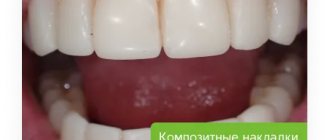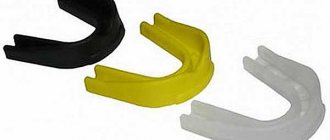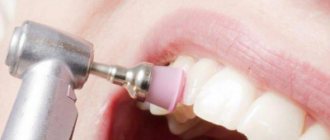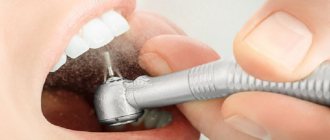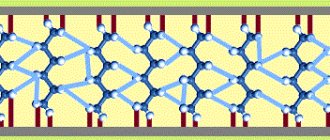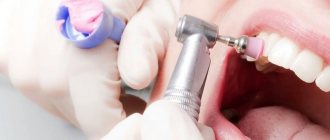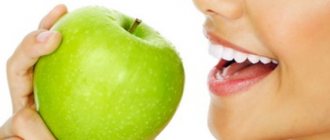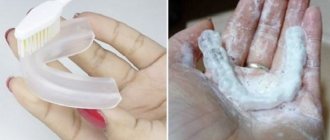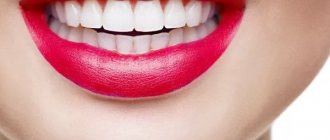What is a mouth guard for?
A boxing mouthguard (cover, plate, dental caps, protective caps) is a special protective device that exactly follows the shape of the human jaw. A correctly selected and applied plate does not cause pain or discomfort to the athlete.
Read also: Caring for a newborn’s navel
A mouthguard is one of the mandatory elements of sports equipment, without which a fighter is not allowed to fight. Its main purpose:
- protecting teeth from falling out or breaking;
- protecting the oral cavity from injury from a chipped tooth;
- protection of gums from cuts;
- preventing the biting of lips, tongue and cheeks during impact;
- reducing the risk of concussion;
- reducing the risk of cervical vertebrae displacement;
- partial protection against knockout.
Unfortunately, newcomers to the world of sports often realize the importance of a mouthguard only after they “lose” a tooth or two in sparring or a fight.
Which mouthguard to choose
When choosing a boxing mouth guard, remember how much a visit to the dentist costs. “Repairing” one tooth will cost more than a good insert.
Production leaders refused to produce double-sided protectors (for both jaws). Therefore, we will not consider them.
Single-sided plates, as you now know, come in one-, two- and three-layer types. Prices for single-layer protectors start from 150 rubles.
A reliable three-layer Everlast mouthguard , with the maximum degree of protection, will cost 1000-1100 rubles.
The process of “cooking” the mouth guard. Why is this necessary?
The “cooking” process involves adjusting the protective plate to the characteristics of your jaw. As a rule, thermoplastic mouth guards are subject to “cooking”. The packaging of this protective element contains detailed instructions for its preliminary preparation before use.
Alternative
After braces, other orthopedic devices are used to maintain the shape of teeth:
- Retainer. It is a non-removable wire structure that is attached to the teeth from the back side. The only inconvenience when using it is the need to visit a dentist for professional cleaning of molars: caries or tartar may form under the wire. Also, retainers cannot be removed or put back on your own if they come off.
- Plate. It is created based on a cast of the patient’s jaw. It consists of a plastic base that fits the upper palate and a metal plate that covers the problem teeth. Removable design, the main disadvantage of which is its unaesthetic appearance.
Retainer
Plate
How to properly weld a mouth guard for boxing
The most popular thermoplastic mouth guards must be “prepared” before use, that is, using heat treatment, they must be adjusted as much as possible to the individual jaw structure. Beginners often have problems with this: one is afraid of overheating the protection, and it does not soften, while another, instead of a mouth guard, ends up with a completely melted piece of material that bears little resemblance to the original product. To avoid wasting money, you can take two copies and practice on the cheapest one first.
Clear teeth marks are visible on the “prepared” mouth guard
How to cook kapa correctly:
- the edges of the mouthguard are trimmed if it is large or causes a gag reflex;
- prepare two bowls, one with boiling water, the second with cold water;
- the mouthguard is immersed for 20-60 seconds (depending on thickness and hardness) in hot water;
- then it is quickly transferred to cold water for a few seconds so as not to get burned;
- The mouthguard is put on the teeth and pressed tightly and bitten, helping with your hands and tongue;
- so that the protection remembers the shape, hold it in the mouth in the desired state for about a minute;
- Finally, the mouth guard is dipped into a container of cold water and waited for 5-10 minutes until it hardens completely.
The result should be an onlay that fits perfectly on the teeth and adheres to them independently. On a properly “prepared” mouth guard, teeth marks are clearly visible, but there are no too thin, almost bitten places. Such protection does not interfere with the boxer, but ensures minimal damage even from crushing blows from the opponent.
Rules of care
Caring for medical mouth guards is extremely simple - just rinse them every day with plain water and clean the inside with a soft-bristled toothbrush. The main thing is to monitor the temperature of the water, since boiling water can deform the plastic.
Important!
It is strictly forbidden to boil, steam or dry products over hot springs for disinfection purposes. It is also undesirable to drink hot drinks and eat too hot and hard food with a mouth guard in your teeth.
Wearing your mouthguard correctly means keeping it clean and washing it regularly, even if it looks very clean. Microorganisms that can harm your teeth can accumulate inside the plastic. Additionally, it is allowed to use special disinfectant solutions that prevent the formation of plaque.
On a note!
If desired, you can purchase box cases for storing aligners: they are very compact and have small holes for ventilation and maintaining optimal humidity.
Boxing mouthguard sizes and flavors
To make boxing comfortable, and for the mouthguard not to interfere with breathing and other functions, it should fit your teeth like a glove. Unfortunately, there is no gradual gradation of sizes; pads are divided into three types: children's, women's, men's. It is necessary, in accordance with age and gender, to choose an available option. If the mouthguard is small, then it is impossible to do anything. An overly large mouth guard can be trimmed from the edges, and then, if it is thermoplastic, the protruding corners can be smoothed out.
The smallest mouthguards are designed for young fighters
An interesting type of mouth guard is flavored. According to manufacturers, they prevent drying of the oral cavity, help normalize breathing and refresh it. Due to the fact that the flavor is embedded in the material, the service life of the mouth guard is long and is not limited to a couple of uses. You can choose protection with the flavors of orange, mint, apple, lemon, and even chewing gum. The downsides are the distraction factor and the fact that the taste gets boring quickly.
How much to wear?
The duration of the retention period (how long the retainers will have to be worn) is calculated by the orthodontist for each patient individually and depends on the following factors:
- The more severe the malocclusion, the longer the aligners will need to be worn.
Difficulty of treatment. The more severe the malocclusion, the longer the aligners will need to be worn.
- Age. The younger the patient, the easier it is to keep the teeth in the desired position and the faster they will finally take it. For minor malocclusions, children sometimes need to wear aligners for only 2-3 hours a day for several months to see improvement, as their maxillofacial apparatus is not yet fully formed and changes easily. Older patients may be forced to use mouth guards throughout their lives to avoid negating the effect of treatment.
- Methods of a specific specialist. Some orthodontists believe that the period of wearing mouth guards should exceed the period of using braces by more than twice. Others are of the opinion that a long retention period is not necessary to maintain the result.
Important: some patients may wear mouth guards longer than the prescribed period to be on the safe side, but they should not be neglected, otherwise the effect of treatment will be lost.
Features of alignment using a mouthguard
To straighten your teeth, you need to visit an orthodontist. The specialist will examine the oral cavity and tell you whether mouth guards can be used. If no contraindications are found, then a three-dimensional cast is made , and then a plaster model and several aligners are created, taking into account individual characteristics. In particularly difficult cases, the kit contains about 30 products.
At the next visit, the first tray is installed, and the rest are given to the patient. During the treatment process, a person replaces the structure every 2-3 weeks. In addition, it is recommended to visit a doctor every 1-1.5 months to monitor the alignment of your teeth.
The duration of treatment directly depends on the degree of deformation of the dentition. In the simplest cases, it will take only 2-4 months to correct the defects, and in complex situations, treatment will take 1-2 years.
Manufacturing
During the preparation, the doctor cleans the little patient’s teeth with ultrasound and, if necessary, treats caries to eliminate sources of infection in the mouth. After this, an impression of the dentition is taken and an X-ray is taken.
In the manufacturer’s laboratory, using computer software, they create a virtual model of the aligners, program the movement of the teeth and the final result. Then a set of individual plates is made using this model. The whole process takes 1-2 weeks. During the fitting, the doctor tells the child and parents how to use and care for the mouth guards.
How to “cook” a mouthguard correctly
Almost all existing thermoplastic linings are prepared according to the same principle, and most often a dental guard for boxing is sold with instructions that indicate everything necessary. In general terms the process looks like this:
We choose any container for boiling water, into which the selected mouthguard can fit entirely.
Place the pan on the fire, let the water boil and lower the cover into it. Make sure it is completely under water.
Keep in boiling water for no more than half a minute.
Remove from the water, wait a few seconds to avoid burns (be careful not to let it cool completely), and place it on your teeth. After this, clench your jaws tightly, apply pressure and press the outer sides of the mouth guard to your teeth.
Proper preparation can be judged by how comfortably and tightly it sits on the teeth when cooled.
Reviews
It took all the endurance and self-control I could muster to straighten my teeth. There was pain, inconvenience, and discomfort, especially at night. The lining sometimes pressed on the teeth, sometimes pulled, and I often wanted to remove it. But the result is gorgeous, the torment was not in vain.
Lyudmila, Saratov
If you have the opportunity to choose mouth guards for your teeth to straighten them, choose them! You get used to it quickly, you don’t have to be embarrassed to open your mouth in public, you can eat anything, your teeth don’t deteriorate - and plus, at the end of the treatment you get straight teeth. Maximum results at minimal costs, not counting financial ones.
Viktor Nikolaevich, Murmansk
How are aligners different from braces?
Both mouthguards and braces are used to correct bites in adults and children, but these designs have significant differences that determine both the disadvantages and advantages of each of them. To make it easier for patients to navigate in choosing the appropriate correction method, below is a table with a comparative analysis of both systems.
Aligners or braces
Table. Mouth guards and braces: comparison.
| Characteristics | Mouthguards | Braces |
| The effectiveness of bite correction | Effective only for minor bite pathologies. | Can be used for severe deformation of the dental system (including severe and complicated cases). |
| Wearing period | From 8-10 months to 2 years. | From 1 year to 2-3 years. |
| Possibility of use in childhood | Can be used in childhood (treatment of bruxism using silicone teethers is especially common). | It is acceptable to use in children over 5 years of age, but the possible risks of enamel damage must be taken into account. |
| Visibility to others | Mouthguards are made of transparent silicone or bioplastic and are practically invisible on the teeth, which makes their use more comfortable and provides psychological comfort to the patient. | Vestibular braces, which are installed on the front surface of the teeth, are clearly visible to others. If these are ordinary metal braces, wearing such a design can cause emotional distress for the patient (especially children and adolescents). |
| Comfort to use | Adaptation to the aligners usually occurs almost immediately after installation. In rare cases, this process may take 3-5 days. | Nagging pain and discomfort when wearing braces can appear at any time as the teeth gradually shift. The duration of such periods can range from 2-3 days to several weeks. |
| Degree of gum trauma | Due to the soft materials, the mouthguards practically do not injure the mucous membranes and soft tissues of the oral cavity. | Braces can have a destructive effect on tooth enamel and damage the mucous membranes of the tongue, lips and gums. |
| Possibility of removal without visiting the dental office | Maybe. | Impossible. |
| Ease of hygienic care | The mouthguard can be easily removed from the mouth to clean the teeth and the structure itself, which ensures a high level of hygiene during orthodontic treatment. | The level of hygiene when using brace systems is quite low due to the inaccessibility of surfaces covered with orthodontic brackets and locks. |
| Price | From 6 to 15 thousand rubles for one mouth guard. | From 70,000 rubles. |
At first glance, it may seem that treatment with mouth guards is a cheaper option compared to braces, but this is not the case. Aligners must be changed regularly, and one set can contain up to 25-30 drops per course of treatment. The total cost of the course is usually more than 200 thousand rubles.
Diagram of the results of treatment with mouthguards
We invite you to read: Chronic periodontitis treatment - Dr. Dent
Treatment of children using FlexiLigner aligners at the “Smile” dentistry
Dentists at the branches of our center use only reliable and proven technologies and devices to treat children. FlexiLigner aligners are one of them. The cost of therapy is from 350 thousand rubles. Treatment with KidsLight aligners costs from 90 thousand. This amount includes the manufacture of mouth guards, monthly visits to the doctor and retention devices.
The dental network offers affordable prices for orthodontic services, payment in installments during the course of correction, and a family discount when servicing several family members.
Our specialists regularly improve their professional status by studying in leading clinics in Russia and Europe. This allows us to offer world-class dental services to our patients.
The clinic has two branches in different areas of Moscow. You can choose the one that is more convenient for visiting:
- branch near the Alekseevskaya metro station (VDNKh area and Mira Avenue) at the address: st. 3rd Mytishchinskaya 3, building 2;
- Shelepikha metro station, address: Shelepikhinskaya embankment, 34, building 1.
It is within your power to make your child’s smile cheerful and beautiful, and to eliminate in advance the problems that he may encounter in the future. Come to our orthodontic centers, we can help you!
Design features
Here we can distinguish three main types, we will arrange them in order of increasing quality and characteristics.
Standard (cast)
These are universal factory mouthguards that do not have outstanding characteristics. They are made of plastic (there are also silicone versions), inexpensive, and quite suitable for beginner amateur athletes. The main disadvantages are poor fixation, standard shape, without the possibility of changes, and insufficient thickness.
Thermocaps (thermoplastic)
This type of mouth guard is a kind of semi-finished product - the product requires individual adjustment, which is done at home (“brewed” and conveys the structural features of the teeth, jaw, and bite). They can have a multilayer structure (a combination of materials is used) and have good fixation.
Custom mouth guards
They are used by professional athletes and are made to order from the dentist (an individual impression of the jaw and bite is made). These mouthguards provide maximum protection and have shock-absorbing properties. Modern technologies make it possible to produce neuromuscular mouthguards that are able to respond to changes in muscle forces (involuntary clench/unclench the jaw) and find the optimal position.
Popular brands
Transparent aligners for teeth straightening are produced by several manufacturers. The most famous and popular are Invisalign, Star Smile and 3D Smile.
- Invisalign was the first to enter the orthodontic device market and gained recognition thanks to the use of modern technology. The entire process of creating aligners is simulated by the Clin Check computer program from Align Technologies.
- The Star Smile brand produces domestic products that are not inferior in quality to their foreign counterparts, but are more affordable. The company sells its products not only in Russia, but also exports them to the USA, Canada, New Zealand, UAE, Australia, neighboring countries, etc.
- 3D Smile is a member of the Skolkovo innovation center, which in just a few years has become one of the top three startups according to Forbes. The company presents its products as a system that combines the advantages of previous generations of braces and aligners with super-precise 3D modeling and printing technologies.
Why do you need dental guards?
Dental mouthguards are needed to correct deficiencies in the dentition. In accordance with the wishes of the patient and the condition of his oral cavity, the doctor selects a suitable system. Mouth guards are placed on the teeth to correct anatomical defects, to consolidate the results of orthodontic treatment, or during teething, to set the teeth in the right direction. Onlays are also used in aesthetic dentistry.
To correct the bite
Most often, transparent overlays are used to correct anatomical defects. They are an alternative to braces and can easily replace metal braces. In this case, aligners have advantages, since they do not require special dietary restrictions and do not interfere with the aesthetics of the smile with metal plates.
On a note!
For adults, this option for correcting defects is ideal. It is less suitable for children, since it is not always possible to control how long the structure will be worn.
Mouthguards for correcting bites require constant wearing. At the initial stages of treatment, they can be removed only for hygiene procedures and during meals. The patient needs to wear the system around the clock, so it cannot be abandoned even at night. You will have to wear aligners to correct your bite from six months to one and a half years, depending on the severity of the anatomical defects. Plates are not suitable for all patients, since in difficult cases the installation of braces is still required.
For teething in children
The eruption of permanent teeth in a child may occur unevenly and untimely. If the baby tooth has not yet fallen out, but the molar is already growing, then it may take on the wrong position.
On a note!
Up to 50% of children aged 8–10 years experience crooked teeth. To avoid having to get braces in the future, you need to take care of the beauty of your smile line now.
Teething mouthguards for children are made individually. Most often, their use is limited to 4-6 months.
For whitening
Trays can be used to lighten enamel. Such designs are most often used at home and do not require an additional visit to the dentist.
The principle of operation of the whitening pad is based on preventing the rapid washing off of the lightening substance from the surface of the tooth. Using a syringe, it is applied to the enamel, after which a tray is secured on top. The wearing period of the system is described in the instructions for use and differs for different whitening substances.
For the treatment and restoration of enamel
Trays for enamel restoration are often used after professional whitening. As a result of exposure, tooth sensitivity increases. For treatment, dentists prescribe remineralizing gels with a high fluoride content. They are applied to the mouthguard, after which the lining is installed on the dentition. For each patient, the treatment period and duration of use of the medicine are determined individually.
For bruxism
Bruxism is a condition in which a person suffers from teeth grinding. Most often this happens unconsciously, during sleep or during stressful situations. Bruxism accelerates the wear of enamel. This leads to increased sensitivity and decreased aesthetics of the smile line. To protect against tooth friction at night, it is recommended to wear mouthguards. They are made of dense elastic material and are worn over the entire surface of the tooth or only half.
Retention systems after wearing braces
Correcting a malocclusion using a braces system is an effective and reliable method. After the jaw and dentition have assumed the correct anatomical position, the staples are removed. However, for old times’ sake, teeth may begin to shift in the opposite direction. Sometimes they take a completely unexpected position. Aligners or retention systems help prevent this complication.
The structures are made of rigid transparent material individually for the patient and require use for 20-22 hours. Such mouthguards hold the teeth in a new position and prevent them from becoming deformed again.
Protective sports
Protective sports systems have different characteristics and indications for use. They are:
- three-layer – suitable for water polo, rugby, hockey, boxing;
- two-layer – required for martial arts, field hockey, skateboarding, basketball and American football;
- single-layer – needed by non-professional athletes, as well as children who play sports.
Important!
When playing some sports, it is necessary to wear a mouthguard, since there is a high risk of tooth injury. This can lead to premature loss of the unit and the need for prosthetics. All this is associated with financial costs and loss of time.
Contraindications
Orthopedic mouth guards are useless for skeletal defects of the jaw bones and the presence of impacted teeth. They are not given to patients with TMJ pathologies, destructive damage to alveolar tissue and severe mental disorders.
Important!
Absolute contraindications include malignant tumors in the oral cavity, tuberculosis, cardiovascular pathologies in the stage of decompensation, autoimmune disorders and diseases in which bone density decreases.
Dental mouthguards are not used for severe diabetes mellitus, serious dysfunction of the thyroid gland, pituitary gland and adrenal glands. They are also contraindicated in cases of diagnosed lymphogranulomatosis, thalassemia, leukemia, hemolytic anemia and HIV.
How to “cook” a boxing mouthguard, instructions (video)
In fact, there is no need to cook the kapa. The workpiece is immersed in hot water (80-90° C) for 30-60 seconds. The exact time and water temperature are indicated in the instructions.
Then the plate is taken out, shaken (or dipped in cold water for 1 second) and put on the teeth.
The plate is pressed on the teeth with your fingers. The insert must be pulled over the gum and pressed tightly against the teeth.
After the protector is placed on the upper jaw, you need to close your teeth and bite down. There is no need to clench your teeth too hard to avoid biting through the protector.
The last step is to immerse the liner in cold water.
To reinforce the information, watch the video. It's easier to see once than to read twice.
What is it used for?
Indications:
- crowding of teeth, which literally “crawl” onto each other and/or grow outside the dentition;
- large gaps between teeth – diastemas and trema;
- deep bite;
- gum disease;
- increased tooth wear;
- dysfunction and pain in the temporomandibular joints (TMJ);
- dysfunction of the musculo-ligamentous apparatus of the face;
- bruxism;
- preparatory stage before implantation;
- improper functioning of the chewing apparatus.


